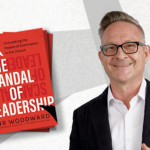*Editorial Note: JR Woodward is one of the founders of Missio Alliance, and a long-time partner with Missio in the holistic development of the local church across North America. Currently he serves as the National Director for Church Planting with V3. His newest book, The Scandal of Leadership, releases at Awakenings 2023 this week, and touches on the intersection of many core issues we will dialogue about during our National Gathering in Chicago. Over the next 3 days, we will preview the introduction to JR’s book as a means of engaging critical leadership content, and as a (written) window into the in-person dialogue we will have together at Awakenings. Part 1can be found here.
JR is graciously donating a portion of his book profits to the ongoing work of Missio Alliance, so if you feel led, you can purchase his book here.
If you’d like to participate virtually in Awakenings 2023, you can still purchase livestream access here, joining us virtually April 27-29, 2023! ~CK
Introduction to The Scandal of Leadership, Part II
Few churches in North America have drawn crowds like Willow Creek Community Church in the northwest of Chicago. In its heyday, it reported a weekly attendance of twenty-five thousand people.1 In a recent case of domination and control, cofounder Bill Hybels resigned from Willow Creek on April 10, 2018, amid allegations of sexual misconduct. His story is important for at least two reasons: First, Hybels hosted a prominent annual conference — the Willow Creek Leadership Summit, which has influenced leaders and pastors worldwide. Second, an independent report on Hybels showed how his domineering leadership led to sexual misconduct.
The Independent Advisory Group issued a seventeen-page report detailing their review process, observations, conclusions, and recommendations.2 The first observation stated, “Allegations were made in two areas, overlapping at times: sexually inappropriate words and actions in relationship with individuals; abuse of power and position.”3 Other relevant observations included how the “descriptions of Bill Hybels’ leadership role as reliant on power, celebrity and position to implement his personal preferences and personnel management are widespread.”4 His approach to leadership was described as “command and control,” which “contributed to executive and leadership turnover.”5 “Board members expressed recurring difficulty in holding Bill Hybels accountable for his leadership and management style.”6 The conclusion of this independent report was that the allegations were credible and that “the credibility of the allegations [was] not based on any one accusation or accuser but on the collective testimony and context of the allegations.”7
COMMON CHARACTERISTICS OF FALLEN LEADERS
High-profile “fallen” leaders often share common characteristics: pride, manipulation, seeking status, isolation, a lack of community to hold them accountable, using status to push an agenda, love of the crowds, an abuse of power and role, a push to “succeed,” and a sense of self-importance. For example, the influential podcast The Rise and Fall of Mars Hill gives a glimpse of what was happening behind the scenes of the church Mark Driscoll was leading. In one of the podcasts, Jesse, who was hired by Mark, confesses how he used his social media skills to promote the brand of both Mars Hill and Mark.8 His efforts were extremely successful, and because of this, Driscoll allotted more and more money to help him build the brand. Driscoll’s podcast rose to the top of the charts. With his successful podcast and a growing church, Driscoll was less willing to allow others to mentor him. In time, his team realized his preaching seemed to be more about Mark than Jesus.9 At one point during a Mars Hill training day, this became particularly evident, as Mark shared for an hour, at one point saying, “I am the brand.”10
SEEKING TO FIND THE CAUSE
When leaders fall to domineering approaches, there typically is a flurry of articles written by teachers, counselors, and practitioners who attempt to explain why the leader has fallen and how to address it.11 Some attribute a leader’s personal behavior and attitude to issues of identity: self-comparison, seeking acclaim, the cessation of a vibrant walk with the Lord, and a false sense of infallibility. Others relate an unbearable level of stress and pressure on leaders in their relationships with congregations. Scott Sauls writes,
It’s easy to put pastors and other public figures on a pedestal. But when people do this, they turn pastors and public figures into objects instead of subjects, personas instead of persons, celebrities instead of neighbors, untouchable heroes instead of the frail image-bearers that we are. This tends to widen the community gap between congregants and their pastors, which in turn isolates pastors significantly. This can be especially true in larger churches.12
In Pastors at Greater Risk, H. B. London Jr. and Neil B. Wiseman ask pastors to recognize that there is a crisis in progress. They offer practical suggestions for attending to marriage and family life, including understanding how to recover from stress and burnout, finding freedom from sexual addiction, and pursuing the practice of personal holiness.13
Licensed professional counselor Michael Todd Wilson and pastor Brad Hoffmann, along with the CareGivers Network, have spent thirty years working to care for “fallen” and hurting pastors, missionaries, and other paid Christian workers. Through collaborative wisdom, they identified three distinct themes of concern for leaders: who the leader is, what the leader values, and how the leader relates. In looking at who the leader is, they address the lack of genuine intimacy in relationship with God, spouse, and others, as well as a distorted sense of calling. Building on this foundation, they then examine what the leader values. Here they address inadequate stress management skills, lack of appropriate boundaries, and the failure to prioritize recreation. Finally, in exploring how leaders relate, they speak of insufficient people skills and underdeveloped leadership skills.14
Pastor and author Alan Roxburgh primarily developed what I refer to as the three contours of leadership: identity, praxis, and telos, although he uses the term work instead of praxis. Others, including myself, prefer praxis.15 I will explore and develop these contours throughout The Scandal of Leadership. But for now, it is enough to say that these terms will help us to understand how the praxis of the leader is significantly informed by the leader’s identity and telos. In the context of leadership, these terms can be defined as follows:
- Identity (being) refers to a sense of self and how it is established.
- Praxis (doing) deals with the practice of leadership as it takes place within the cycle of thought, action, and reflection.
- Telos (becoming) is indicative of the end goal of leadership, both for the leader’s life and where they are leading the church. Telos signifies the true end.16
In many ways, the three distinct themes of concern that Wilson and Hoffmann identify reflect the three contours of leadership. (See Table I.1. below.)
Contours of Leadership and Areas Needing Healing
| CONTOURS OF LEADERSHIP | AREAS NEEDING HEALING |
| Identity | Who the leader is |
| Praxis | How the leader relates |
| Telos | What the leader values |
In the CareGivers report, the authors address the unique challenges of vocational ministry.17 Two stressors they highlight relate to the identity of the leader. The first occurs when the congregation tends to put the leader on such a high pedestal that they are considered godlike and are no longer seen “as human beings with feet of clay.”18 The second is when ministers with a personal sense of inadequacy “put on an air of confidence,” presenting a “perfect” public image.19 Therefore the identity of the leader—who the leader is—is foundational in forming strategies to prevent abuse.20 This study suggests that the symptoms found in high-profile leaders are not unique to their levels of influence but seem to be common struggles for leaders at many levels of influence.
The diagnosis and remedy of these various resources are extremely helpful, as they encourage a healthier psychology, relationality, and spirituality. However, this is merely the tip of the iceberg.
A MORE COMPREHENSIVE EXAMINATION
My hope is that I will offer a more comprehensive missiological understanding of the problem of domineering leadership. Missional theology begins with the metanarrative of Scripture that moves from creation through the fall to new creation and the missio Dei, which is the work of God in making all things new.21 A critical but often overlooked part of that narrative is how the fall not only affected humanity but also social and cosmic realities.22 From the garden to Christ’s temptation in the desert all the way to the beast and dragon in John’s revelation, there are Powers manifest through social realities that actively warp God’s intentions for the world. But the good news is that the life, death, and resurrection of Jesus represents the victory of God over the Powers.23 In an attempt to understand how this dynamic shapes the present and dictates the future, some missiologists have sought to retrieve the biblical language of the Powers.24 The Scandal of Leadership deals with both power and the Powers (Satan, the demonic, principalities, and powers). The Powers as a catch-all term will be capitalized. When speaking to just one aspect of the Powers — such as the principalities and powers, the demonic, or just the term power — capitalization will not be used.
I will take these incipient arguments and apply them to leadership, in both its fallen and redeemed states. “Fallen” leadership occurs when leaders forsake the mission of God in the way of Christ through the Spirit and instead move (knowingly or unknowingly) toward imitation of the Powers to achieve the leader’s agenda.
I will demonstrate the link between leadership, imitation of desire, and the Powers. As this link is developed, it will become evident how the Powers seek to subvert us in shrewd ways and easily influence us to “fall” into patterns of domination. In addition, I seek to make the case that “fallenness” is driven by malformed desires and that the reshaping of our desires should be at the heart of leadership formation. After the link between imitation and desire is made, I suggest that the primary way to reshape our desires is through imitating the desires of Christ, who found his identity and telos in God and the mission of God. Finally, as leaders, if we seek to imitate Christ and live our lives in God, our desires can be reshaped, and we can subsequently become positive models for imitation in the church, which leads to genuine discipleship and healthy multiplication.
When leaders fall to domineering leadership, it does not always lead to a resignation or removal from leadership. However, I argue that domineering leadership does always lead to rivalry, chaos, and scapegoating in the congregation and thus a poor witness to the world. Redeemed leadership is reflected in the apostle Paul’s appeal to the Corinthians to “be imitators of me, as I am of Christ” (1 Cor. 11:1 ESV). Thus, the central question I seek to address is the following:
How might a theology of the Powers help us as missional leaders practice a spirituality that reshapes our desires for the sake of discipleship, community, and mission?
Domineering leadership hurts people and damages the witness of the church, so it is therefore important to develop a proper diagnosis. Albert Einstein reputedly once said that if he had only one hour to solve a problem in which his life actually depended on the solution, he would spend the first fifty-five minutes determining the proper question to ask.25 If he knew the right question to ask, he could solve the problem in less than five minutes. This book focuses on the fifty-five minutes of that hour, seeking to ask the right questions and uncovering what is below the tip of the iceberg.
///
REFLECTIVE QUESTIONS TO PONDER
-
- What do you feel is the reason for the fall of so many well-known leaders?
- In books that you have read or podcasts that you have listen to, how often do people bring up the Powers when seeking to find why leaders fall? Why do you think this is the case?
- Why is it important to give a deep diagnosis to the problem of domineering leadership before moving to a remedy?
///
JR Woodward, PhD (University of Manchester, UK) loves to awaken people to join God in the renewal of all things. He is a catalyst who has been passionately starting churches and ministries for the good of the world for over twenty-five years. He co-founded Missio Alliance and currently serves as the National Director for the V3 Church Planting Movement. He is an adjunct professor at several seminaries and universities, including Central Seminary and Missio Seminary. He is the co-founder of the Praxis Gathering, and serves on six different boards, including Reliant Mission, Movement Leaders Collective, and Fuller Global Mission Advisory Council. He is the author of Creating a Missional Culture, and co-author of The Church as Movement. His most recent book The Scandal of Leadership is based on his PhD research, and written to provide a remedy to the problem of domineering leadership in the church. He loves to surf, travel, read, and skateboard as well as meet new people. He enjoys photography and film and tries to attend the Sundance Film Festival whenever he can. Find him online at jrwoodward.com.
Footnotes
1 Outreach 100, “2015 Largest Churches in America,” accessed October 25, 2021, https://outreach100.com/largest-churches-in-america/2015.
2 Jo Anne Lyon et al., “Independent Advisory Group Report,” 2019, https:// www.willowcreek.org/-/media/images/7-0-about/elders2019/iagreport-022819.
3 Ibid., 4.
4 Ibid., 6.
5 Ibid.
6 Ibid.
7 Ibid., 13.
8 Mike Cosper, “The Brand,” August 2, 2021, in The Rise and Fall of Mars Hill, produced by Christianity Today, podcast, 10:10, https://www.christianitytoday.com/ ct/podcasts/rise-and-fall-of-mars-hill/rise-fall-mars-hill-podcast-mark-driscollbrand.html.
9 Ibid., 20:32, 45:24, 48:04, 52:30, and 55:55.
10 Mike Cosper, “Who Killed Mars Hill?” June 21, 2021, in The Rise and Fall of Mars Hill, produced by Christianity Today, podcast, 17:38, https://www. christianitytoday.com/ct/podcasts/rise-and-fall-of-mars-hill/who-killed-mars-hillchurch-mark-driscoll-rise-fall.html.
11 Roger E. Olson, “Evangelical Superstars and Why They Fall,” Patheos, August 30, 2014, https://www.patheos.com/blogs/rogereolson/2014/08/evangelicalsuperstars-and-why-they-fall/; James Emery White, “The Pastoral Mess of 2016,” Crosswalk, January 5, 2017, https://www.crosswalk.com/blogs/dr-james-emerywhite/the-pastoral-mess-of-2016.html; Garrett Kell, “A Pattern among Fallen Pastors—Lessons for Us All,” All Things for Good (blog), February 20, 2015, http:// garrettkell.com/pattern-among-fallen-pastors-lessons-us/; Eddie Kaufholz, “The Mega-Problem Behind the ‘Falls’ of Megachurch Pastors,” Relevant, November 6, 2020, https://relevantmagazine.com/current16/mega-problem-behind-falls-megachurch-pastors/; Scott Sauls, “On the Rise and Fall of Pastors,” Scott Sauls (blog), May 15, 2020, https://scottsauls.com/blog/2020/05/15/pastors/.
12 Scott Sauls, “The Plight of the Falling Pastor,” Interview by Daniel Darling, Christianity Today, June 24, 2016, https://www.christianitytoday.com/ pastors/2016/june-web-exclusives/plight-of-falling-pastor.html.
13 H. B. London Jr. and Neil B. Wiseman, Pastors at Greater Risk (Grand Rapids, MI: Baker Books, 2003).
14 Michael Todd Wilson and Brad Hoffmann, Preventing Ministry Failure: A Shepherd Care Guide for Pastors, Ministers and Other Caregivers (Downers Grove, IL: InterVarsity Press, 2007).
15 Alan Roxburgh uses identity and telos and work of the leader. I chose to use praxis instead of work. These terms are affirmed by others addressing the dearth of literature in regards to theological reflection on leadership: Alan J. Roxburgh and Fred Romanuk, The Missional Leader: Equipping Your Church to Reach a Changing World (San Francisco, CA: Jossey-Bass, 2006); Michale Ayers, “Toward a Theology of Leadership,” Journal of Biblical Perspectives in Leadership 1, no. 1 (Fall 2006): 3–27; Chloe Lynch, Ecclesial Leadership as Friendship (New York: Routledge, 2019).
16 Each contour of leadership has a corresponding temptation of image (identity), institution (praxis), and ideology (telos). William Stringfellow named these temptations, and in chapter 10 of this book, I will be linking them to these areas of leadership.
17 Wilson and Hoffmann, Preventing Ministry Failure, 16.
18 Ibid., 17.
19 Ibid., 18.
20 Ibid., 26.
21 Christopher J. H. Wright, The Mission of God: Unlocking the Bible’s Grand Narrative (Downers Grove, IL: IVP Academic, 2006).
22 The following are some works on the Powers from a distinctly missional point of view. (Only the Power and the Powers has a chapter specifically on leadership and the Powers.) Thomas H. McAlpine, Facing the Powers: What Are the Options? (Eugene, OR: Wipf and Stock, 2003); Andrew Hardy, Dan Yarnell, and Richard Whitehouse, ed., Power and the Powers: The Use and Abuse of Power in Its Missional Context (Eugene, OR: Cascade Books, 2015); James V. Brownson et al., StormFront: The Good News of God (Grand Rapids, MI: William B. Eerdmans, 2003); A. Scott Moreau, ed., Deliver Us from Evil: An Uneasy Frontier in Christian Mission (Monrovia, CA: World Vision International, 2002); Loren L. Johns and James R. Krabill, eds., Even the Demons Submit: Continuing Jesus’ Ministry of Deliverance (Scottdale, PA: Institute of Mennonite Studies, 2006).
23 N. T. Wright, Jesus and the Victory of God (Minneapolis, MN: Fortress, 1997); N. T. Wright, Evil and the Justice of God (Downers Grove, IL: IVP, 2013); N. T. Wright, The Day the Revolution Began: Reconsidering the Meaning of Jesus’s Crucifixion (New York: HarperOne, 2018); Walter Brueggemann, Truth Speaks to Power: The Countercultural Nature of Scripture (Louisville, KY: Westminster John Knox, 2013).
24 Lesslie Newbigin, The Gospel in a Pluralist Society (Grand Rapids, MI: William. B. Eerdmans, 1989); Lois Barrett, “Missional Witness: The Church as Apostle to the World,” in Missional Church: A Vision for the Sending of the Church in North America, ed. Darrell L. Guder (Grand Rapids, MI: William B. Eerdmans, 1998).
25 I say reputedly, because it was not a part of his written corpus. Though it is popularly espoused, it cannot be confirmed.





Missio Alliance Comment Policy
The Missio Alliance Writing Collectives exist as a ministry of writing to resource theological practitioners for mission. From our Leading Voices to our regular Writing Team and those invited to publish with us as Community Voices, we are creating a space for thoughtful engagement of critical issues and questions facing the North American Church in God’s mission. This sort of thoughtful engagement is something that we seek to engender not only in our publishing, but in conversations that unfold as a result in the comment section of our articles.
Unfortunately, because of the relational distance introduced by online communication, “thoughtful engagement” and “comment sections” seldom go hand in hand. At the same time, censorship of comments by those who disagree with points made by authors, whose anger or limited perspective taints their words, or who simply feel the need to express their own opinion on a topic without any meaningful engagement with the article or comment in question can mask an important window into the true state of Christian discourse. As such, Missio Alliance sets forth the following suggestions for those who wish to engage in conversation around our writing:
1. Seek to understand the author’s intent.
If you disagree with something the an author said, consider framing your response as, “I hear you as saying _________. Am I understanding you correctly? If so, here’s why I disagree. _____________.
2. Seek to make your own voice heard.
We deeply desire and value the voice and perspective of our readers. However you may react to an article we publish or a fellow commenter, we encourage you to set forth that reaction is the most constructive way possible. Use your voice and perspective to move conversation forward rather than shut it down.
3. Share your story.
One of our favorite tenants is that “an enemy is someone whose story we haven’t heard.” Very often disagreements and rants are the result of people talking past rather than to one another. Everyone’s perspective is intimately bound up with their own stories – their contexts and experiences. We encourage you to couch your comments in whatever aspect of your own story might help others understand where you are coming from.
In view of those suggestions for shaping conversation on our site and in an effort to curate a hospitable space of open conversation, Missio Alliance may delete comments and/or ban users who show no regard for constructive engagement, especially those whose comments are easily construed as trolling, threatening, or abusive.